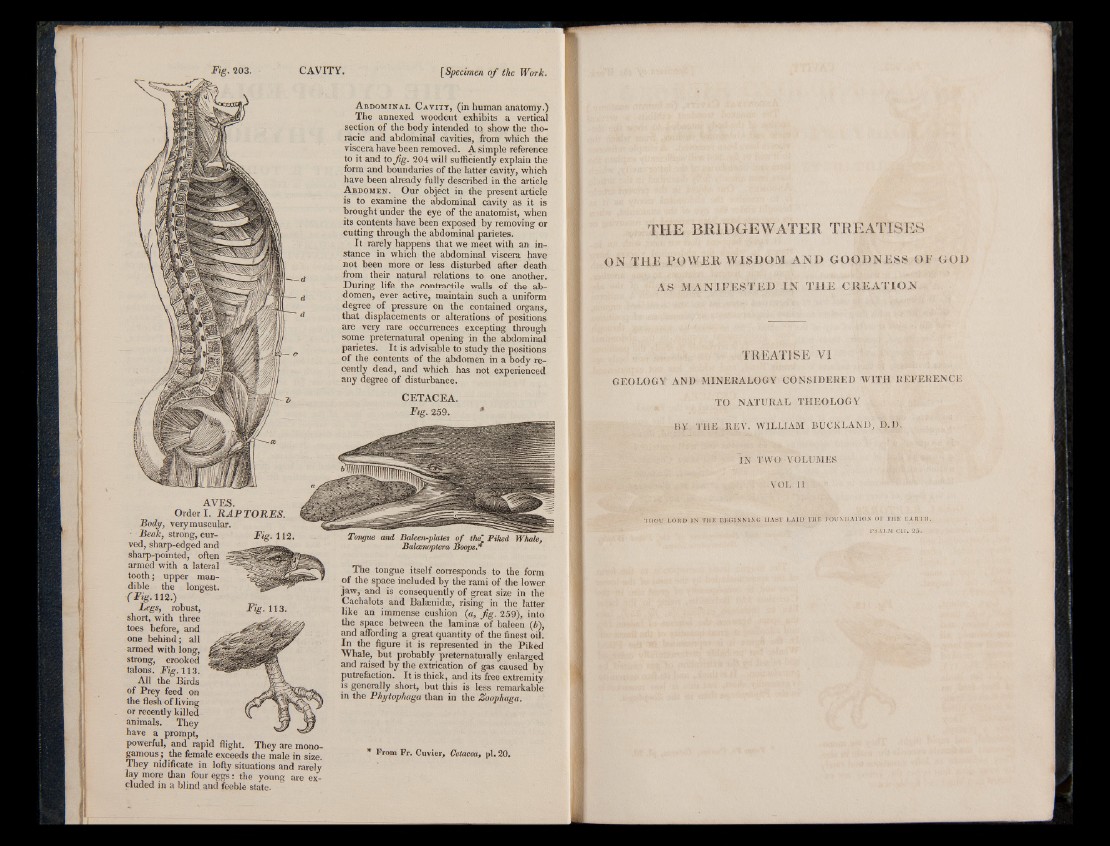
CAVITY. Fig. 203. [Specimen o f the Work.
Abdominal C avity, (in human anatomy.)
The annexed woodcut exhibits a vertical
section of the body intended to, show the thoracic
and abdominal cavities, from which the
viscera have been removed. A simple reference
to it and to fig. 204 will sufficiently explain the
form and boundaries of the latter cavity, which
have been already fully described in the article
A bdomen. Our object in the present article
is to examine the abdominal cavity as it is
brought under the eye of the anatomist, when
its contents have been exposed by removing or
cutting through the abdominal parietes.
It rarely happens that we meet with an instance
in which the abdominal viscera have
not been more or less disturbed after death
from their natural relations to one another.
During life the contractile walls of the abdomen,
ever active, maintain such a uniform
degree of pressure on the contained organs,
that displacements or alterations of positions
are very rare occurrences excepting through
some preternatural opening in the abdominal
parietes. It is advisable to study the positions
of the contents of the abdomen in a body recently
dead, and which has not experienced
any degree of disturbance.
CETACEA.
Fig. 259.
AVES.
Order I. RAP TO RE S .
Body, verymuscular.
• Beak, strong, cur- Fig. 112.
ved, sharp-edged and
sharp-pointed, often
armed with a lateral
tooth ; upper mandible
the longest.
(Fig. 112.)
Legs, robust, Fig. 113.
short, with three . .
toes before, and
the flesh of living
or recently killed \ I l
animals. They
have a prompt, '***'
powerful, and rapid flight. They are monogamous
; the female exceeds the male in size.
They nidificate in lofty situations and rarely
lay more than four eggs : the young are excluded
in a blind and feeble state.
Tongue and Baleen-plates o f the" Piked Whale,
Balcenoptera Boops.^
The tongue itself corresponds to the form
of the space included by the rami of the lower
jaw, and is consequently of great size in the
Cachalots and Balaenidae, rising in the latter
like an immense cushion (a, fig. 259), into
the space between the laminae of baleen (5),
and affording a great quantity of the finest oil.
In the figure it is represented in the Piked
Whale, but probably pretematurally enlarged
and raised by the extrication of gas caused by
putrefaction. It is thick, and its free extremity
is generally short, but this is less remarkable
in the Phytophaga than in the Zoopliaga.
* From Fr. Cuvier, Cetacea, pi. 20.
THE BRIDGEWATER TREATISES
ON THE POW E R WISDOM AND GOODNESS OE GOD
AS MANIFESTED IN THE CREATION
TREATISE VI
GEOLOGY AND MINERALOGY CONSIDERED WITH R EFERENCE
TO NATURAL THEOLOGY
BY THE REV. WILLIAM BUCKLAND, D.D.
TI10U LORD 1
IN TW O V O L UM E S
V O L 11
N THE BEGINNING HAST LAID THE FOUNDATION OF THE EARTH.
PSALM GIT. 25.